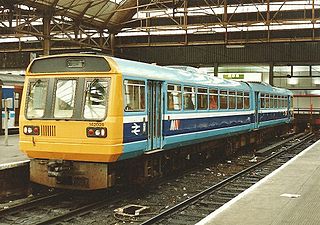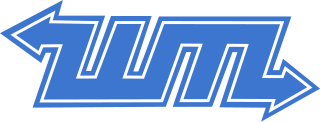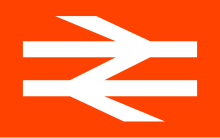British Railways (BR), which from 1965 traded as British Rail, was a state-owned company that operated most rail transport in Great Britain from 1948 to 1997. Originally a trading brand of the Railway Executive of the British Transport Commission, it became an independent statutory corporation in January 1963, when it was formally renamed the British Railways Board.
National Rail (NR) is the trading name licensed for use by the Rail Delivery Group, an unincorporated association whose membership consists of the passenger train operating companies (TOCs) of England, Scotland, and Wales. The TOCs run the passenger services previously provided by the British Railways Board, from 1965 using the brand name British Rail. Northern Ireland, which is bordered by the Republic of Ireland, has a different system. National Rail services share a ticketing structure and inter-availability that generally do not extend to services which were not part of British Rail.

The Tube map is a schematic transport map of the lines, stations and services of the London Underground, known colloquially as "the Tube", hence the map's name. The first schematic Tube map was designed by Harry Beck in 1931. Since then, it has been expanded to include more of London's public transport systems, including the Docklands Light Railway, London Overground, the Elizabeth line, Tramlink, the London Cable Car and Thameslink.
The Rail Delivery Group Limited (RDG), previously the Association of Train Operating Companies, is the British rail industry membership body that brings together passenger and freight rail companies, Network Rail and High Speed 2. The RDG is approximately half-funded by Network Rail, the remainder of its funding being provided by the various transport groups it represents.

The Tyne and Wear Metro is an overground and underground light rail rapid transit system serving Newcastle upon Tyne, Gateshead, North Tyneside, South Tyneside, and the City of Sunderland. It has been described as the "first modern light rail system in the United Kingdom". The system is currently both owned and operated by the Tyne and Wear Passenger Transport Executive (Nexus), thus is fully under public ownership and operation.

Strathclyde Partnership for Transport (SPT) is a regional transport partnership for the Strathclyde area of western Scotland. It is responsible for planning and coordinating regional transport, especially the public transport system in the area, including responsibility for operating the Glasgow Subway, the third-oldest in the world.

InterCity was a brand name introduced by British Rail in 1966 for its long-haul express passenger services.

British Rail was the brand image of the nationalised railway owner and operator in Great Britain, the British Railways Board, used from 1965 until its breakup and sell-off from 1993 onwards.

Sealink was a ferry company based in the United Kingdom from 1970 to 1984, operating services to France, Belgium, the Netherlands, Isle of Man, Channel Islands, Isle of Wight and Ireland.

Rail Alphabet is a neo-grotesque sans-serif typeface designed by Jock Kinneir and Margaret Calvert for signage on the British Rail network. First used at Liverpool Street station, it was then adopted by the Design Research Unit (DRU) as part of their comprehensive 1965 rebranding of the company.

Overground Network was a branding initiative launched in 2003 by the Strategic Rail Authority (SRA) and Transport for London (TfL), the public transport authority in London, England. Its aim was to encourage use of National Rail services in South London. The project was a partnership between the SRA, TfL, three train operating companies, the South and West London Transport Conference (SWELTRAC) and the South East London Transport Strategy (SELTRANS). The scheme is no longer being promoted and the Overground Network project has since been abandoned.

London Overground is a suburban rail network serving London and its environs. Established in 2007 to take over Silverlink Metro routes, it now serves a large part of Greater London as well as Hertfordshire, with 113 stations on the six lines that make up the network.
In the ticketing system of the British rail network, tickets are normally issued to and from individual stations. In some instances, when there is more than one station in a town or other locality—especially where these are on different routes—it may be desirable for passengers to be able to travel to one station and back from another, or more generally to be able to choose which of the stations they wish to travel to. To accommodate this requirement, British Rail introduced a series of station groups: notional "common locations" to which tickets from stations outside that group would be issued.
The history of rail transport in Great Britain 1948–1994 covers the period when the British railway system was nationalised under the name of 'British Railways', latterly known as British Rail until its eventual privatisation in 1994.

The history of British Rail's corporate liveries is quite complex. Although from the mid-1960s to the 1980s the organisation was associated with "Rail Blue", a number of other schemes were also used, especially when it was split into operating units or "sectors" in the mid-1980s.

Network NorthWest was a brand name of British Rail which was applied for a short period to the provincial railway network in North West England. It was launched in 1989 during British Rail's sectorisation programme which created distinct brand identities for regional sub-divisions.

ScotRail has been the brand name used for all Scottish regional and commuter rail services, including some cross-border services, since September 1983, as well as many of the country's intercity services.

The West Midlands Passenger Transport Executive (WMPTE) was the public body responsible for public transport in the West Midlands metropolitan county in the United Kingdom from 1969 until 2016. The organisation operated under the name Centro from 1990, and was publicly branded as Network West Midlands from 2005.

The British Rail Corporate Identity Manual is a corporate identity guide created in 1965 by British Rail. It was conceived in 1964, and finished in July 1965 by British Rail's Design Research Unit, and introduced British Rail's enduring double arrow logo, created by Gerald Barney and still in use today as the logo for National Rail. The manual spanned four volumes, and was created as part of a comprehensive redesign of British Rail following the Beeching Cuts as part of a plan to attract more passengers. It is noted as a piece of British design history.
Great British Railways (GBR) is a proposed state-owned public body that is to oversee rail transport in Great Britain except for Transport for London, Merseytravel, light rail and tram services. It is to assume most rail functions of the Department for Transport (DfT) and the Rail Delivery Group, including procuring services and setting fares. In addition, it is to absorb Network Rail to become the operator of most rail infrastructure across Great Britain. It will not affect the existing powers of the UK's devolved administrations in their areas.














